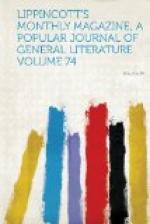girls to domestic service, the girls to be chosen
from among the children of the lower school.
In this latter school each girl stays four years,
and the system has worked so well that the scholars
are greatly sought after as servants. At the
age of twenty-two any girl, educated there, who can
produce good testimonials while in service, may become
a candidate for a marriage-portion of one hundred
pounds. Six girls draw for it on May Day, and
six on the Fifth of November, the unsuccessful ones
being entitled to draw again from time to time until
they get it. The drawing is preceded by a special
service in the parish church, the boys and girls from
the lower schools being present, and going in procession
from the school to the church arrayed in quaint, old-fashioned
costume. The former wear a half-nautical costume,
the neighborhood being in many ways connected with
sea-pursuits: the latter are dressed in blue
stuff gowns, a white apron and a handkerchief folded
over the breast, and a small white cap bound round
with a Blue ribbon. Every one, from the gorgeous
beadle to the youngest child, has also a bouquet of
flowers on this occasion. The beadle is an “institution”
that has disappeared in America, but which still looms
in awful official grandeur before the mind’s
eye of every London-bred child. On these occasions
he is in all his glory: his military costume
and silver-headed staff are the very embodiment of
dignity, and to the less awed spectator of riper years
he fills in a niche of old-time conventionality very
picturesquely. The service is followed by the
wedding of the successful candidate of the previous
occasion, so that each of the two memorable days becomes
a double festival. The bells strike a merry peal,
and the procession forms once more and goes back to
the Asylum, where, in a curious apartment, the walls
of which are covered with the names of donors to the
charity, the drawing takes place. The girls of
the Asylum enter the room and begin by singing a short
hymn, accompanied by an old-fashioned organ.
The treasurer of the Asylum Fund, in exact compliance
with the explicit directions of the founder’s
charter, takes a half sheet of white paper and writes
the words “One Hundred Pounds” on it, then
five other blank half sheets, and wraps each tight
round a little roller of wood tied with a narrow green
ribbon. The knot of each is then firmly sealed
with red sealing-wax, and all the rolls formally deposited
in a large canister placed on a small table in the
middle of the room. There is nothing else on
the table except a candle in a small candlestick,
to be used in sealing the rolls. The treasurer
stands by as each candidate draws, and when all the
rolls are drawn the girls go up to the chairwoman
(generally the rector’s wife), at the upper end
of the room. She then cuts the ribbon of each
and returns the roll to its owner. It is not
long before the fortunate one is recognized. The
scene is full of interest even to a stranger, and was




